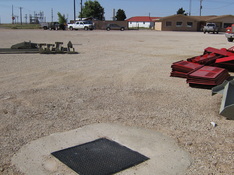Recovery wells are used to extract contaminated groundwater and free product (phase separated on top of a given aquifer) on a long term or short term basis. Recovery wells vary in size from 1” to 8” depending on site conditions, depth to groundwater, subsurface lithology, and the drilling method utilized. Because every drill site is different based on lithology, surface utilization, regulatory requirements, budgets and safety concerns the installation of recovery wells may vary. The free product or dissolved product may be treated and disposed according to state and federal regulations or if the recovered product is a viable commodity it can be reintroduced into the refining process.
Recovery Wells vs. Monitor Wells
Recovery wells differ from monitor wells in that monitor wells are setup to test subsurface water in a particular zone. They not only measure the water levels but also retrieve water samples for laboratory analysis.
Recovery wells are installed to retrieve contaminated water and free product. While having numerous monitor wells is typical warranted to properly assess a contaminated site. Recovery wells typically have a larger diameter to achieve greater recovery of groundwater than monitor wells. The more recovery wells that are installed at a site may allow for a larger radius of influence to capture free product. This allows for cost effective and rapid cleanup of contaminated groundwater. T he recovery wells should be located just inside the edge of the leading plume and in any area with free product.
he recovery wells should be located just inside the edge of the leading plume and in any area with free product.
How Does Recovery Well Production Work?
In theory, a recovery well will produce as much water as the entire formation will transmit; but this is not always the case. Depending on the well construction and installation a well may only produce a fraction of its total potential. This is where choosing a drilling company with experience installing recovery wells will pay dividends.
One of the biggest factors in recovery well production is choosing the proper installation procedures for subsurface lithology and type of free product that is being recovered. the proper installation includes: correct drilling method, proper installation of screen and casing, selecting the correct size screen slot, filter pack, proper development, and surface completion for site conditions. Many believe that having the largest screen and filter pack available will increase production. This is not the case.
Every recovery well is unique and will require specialized planning and drilling technologies. If you need recovery wells installed in Texas, give Talon/LPE Drilling Services a call today. They are the environmental drilling specialists in the states of Texas, Oklahoma and New Mexico. No matter the project, they provide environmentally sound and safe drilling services to clients.

